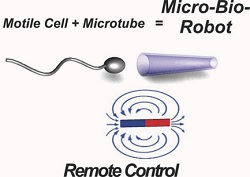 |
| Sperm-driven micro-robots could deliver drugs.--Courtesy of the Institute for Integrative Nanosciences |
To get microscopic drug carriers swimming toward a target, German researchers took a cue from some of the best swimmers in nature: sperm cells.
Scientists from the Institute for Integrative Nanosciences in Dresden used live flagella from bull sperm to maneuver nanotubes in a singular direction using magnets. These swimming micro-robots could have a number of applications, according to a New Scientist report, including human fertilization and the delivery of drugs to targets within the body. The team published their findings in the journal Advanced Materials.
To make the biohybrid, the team constructed tiny, hollow cone-shaped tubes that, when mixed with the bovine sperm, captured the live cells head first. Because of the shape of the tube--think of a lobster trap--the sperm cells would get stuck head first in the tubes with their flagella free to move and propel the entire compound forward.
But at this point, the micro-robots had no targeted direction in which to swim. To remedy this aimlessness, the researchers used external magnetic fields and controlled the direction the cell was facing. That way, the flagella would push the entire biohybrid in one direction.
Lead scientist Oliver Schmidt told New Scientist that the reason sperm cells are ideal is that they are safe in the human body, self-powered and can swim through thick liquids.
Drug delivery scientists are constantly looking for new ways to actively propel drugs toward a target. From spinning propellors to self-propelled micro-rockets, these new materials could usher in a new era of targeted delivery, and the use of a natural mechanism of propulsion such as flagella marks a new way to approach the problem.
- here's the New Scientist report
- and here's the journal abstract